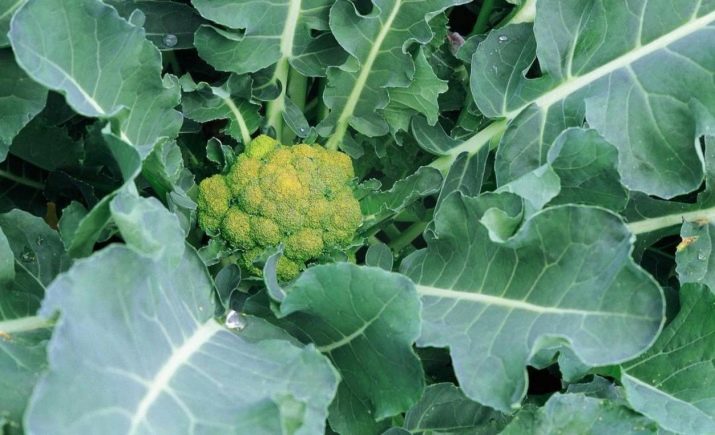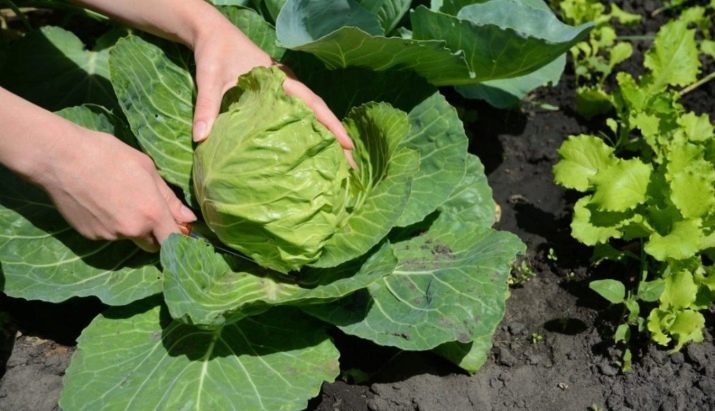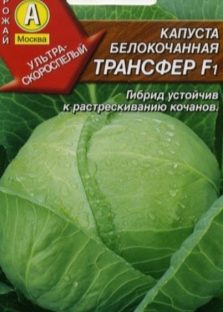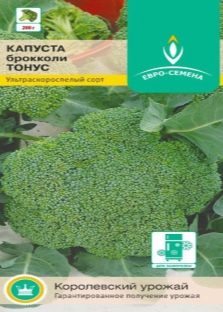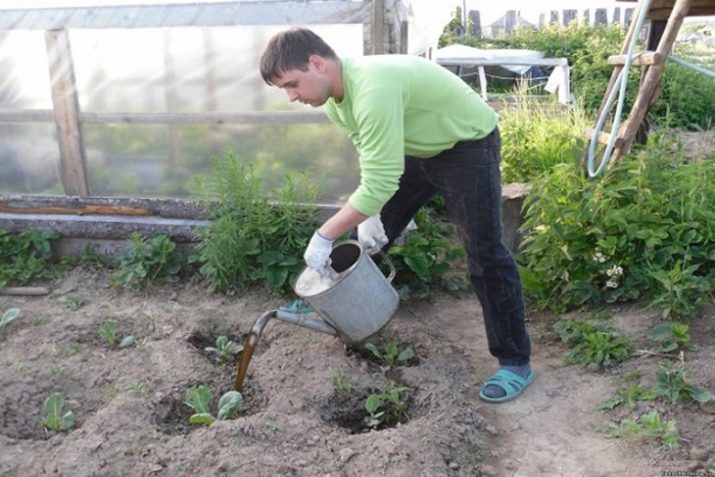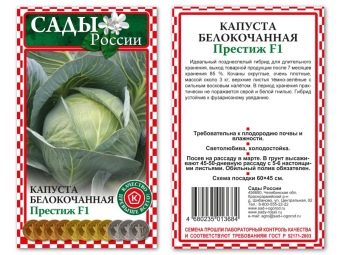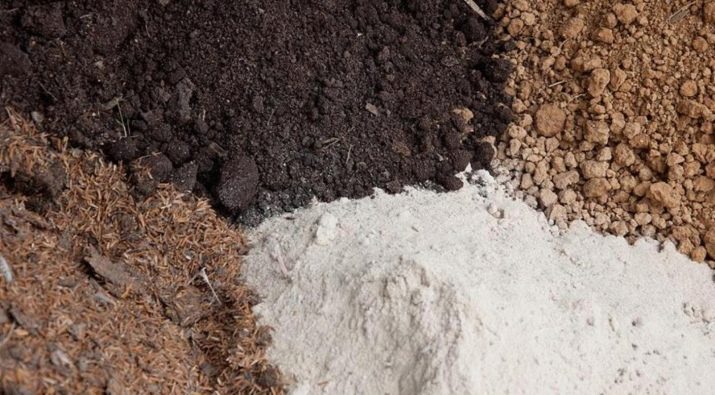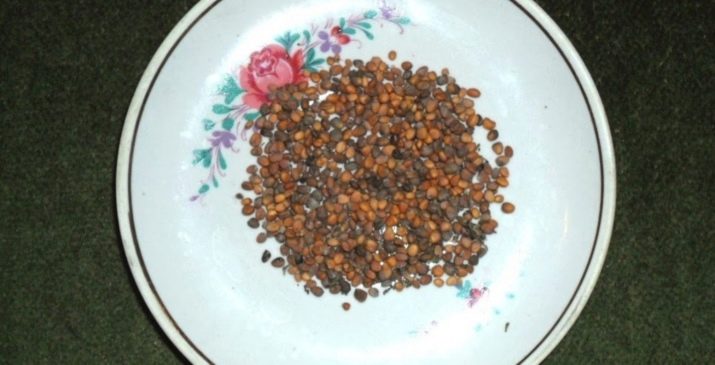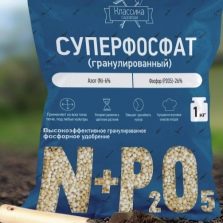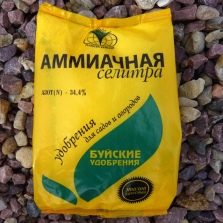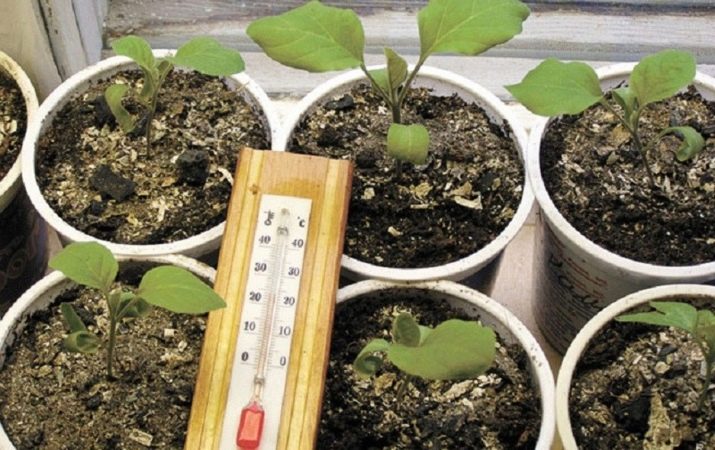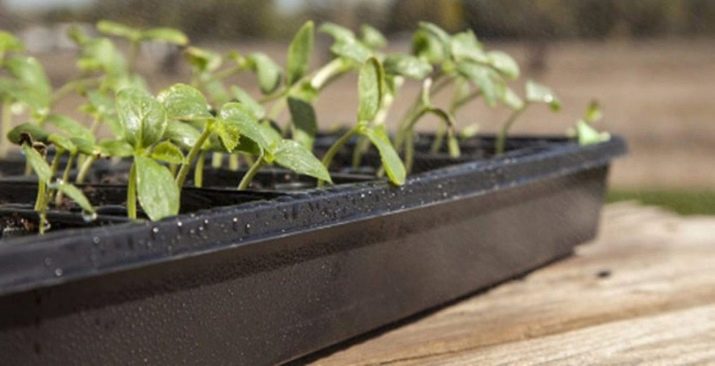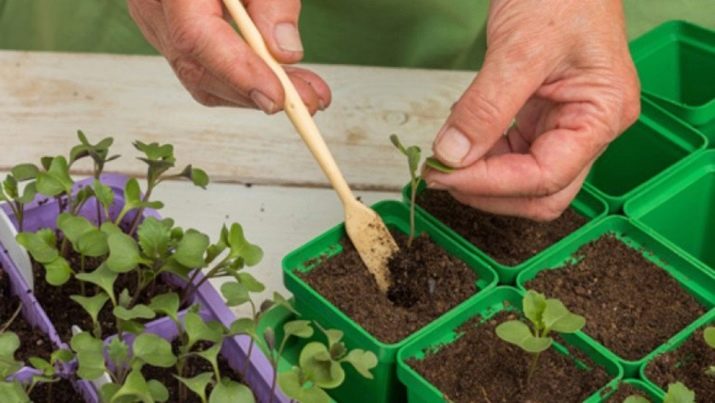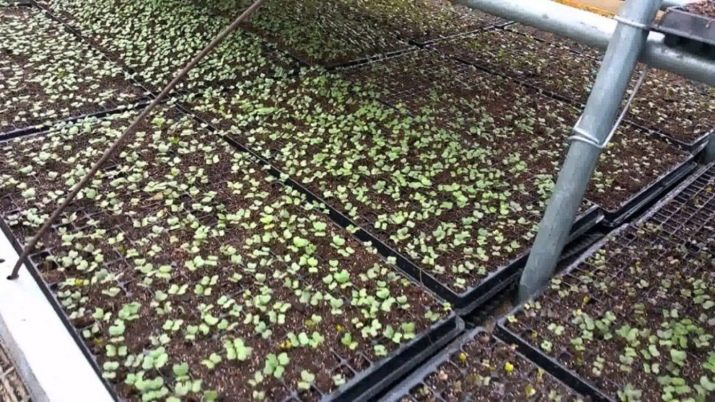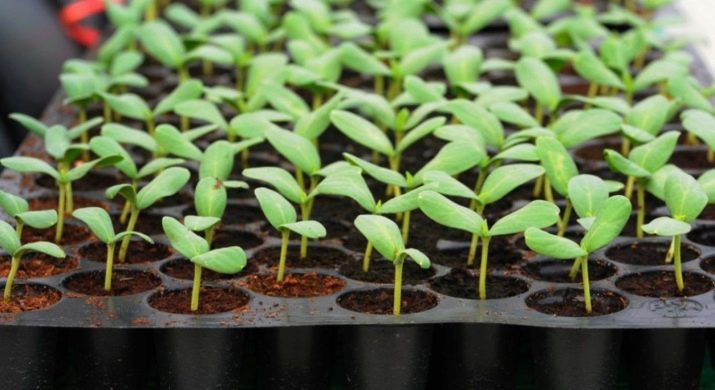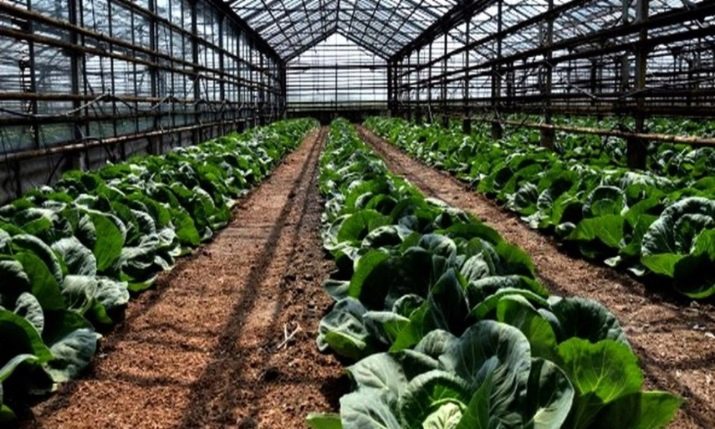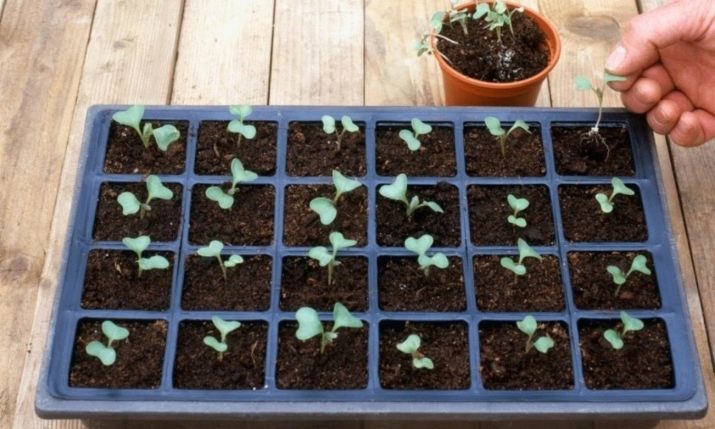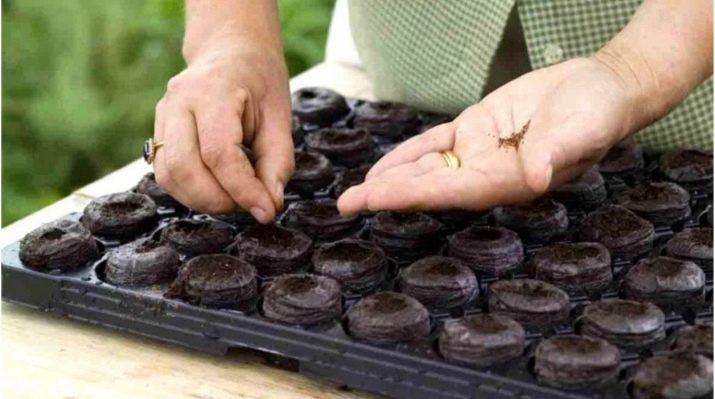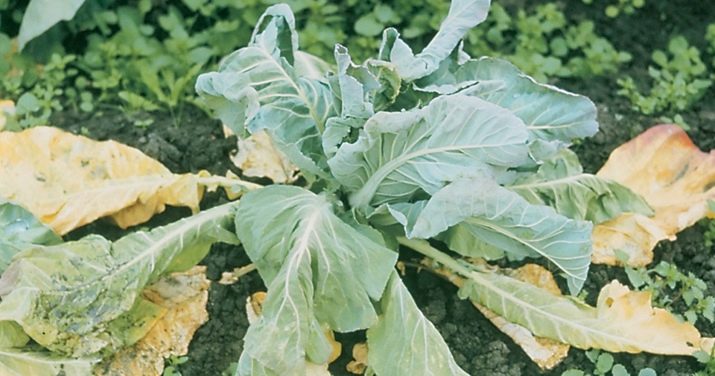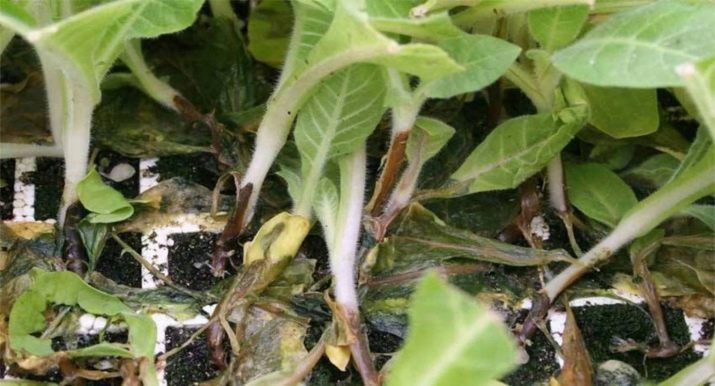We plant cabbage on seedlings: when to sow and how to grow properly?
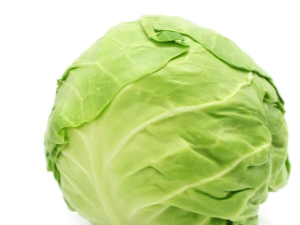
Almost every gardener chooses cabbage for seedlings, as this vegetable is suitable not only for creating nutritious salad, but also for making other recipes. To get healthy plants, you need to familiarize yourself with information about when to sow and how to grow cabbage properly.
Terms of planting vegetables
Before you start planting future cabbage, you need to get acquainted with the features of planting. Planting seeds at home should be based on the variety of future vegetables, climatic conditions and the region. You will also need to study the favorable days affected by the phase of the moon. This fact has been proven by scientists, so the movement of a celestial body has a direct impact on the landing of plants.
By region and lunar calendar
Most gardeners prefer to start sowing cabbage based on data from the lunar calendar. According to long-term observations, it is optimal to plant seedlings at home during the period when the moon grows. This preference is due to the fact that during this period there is an increase in seed growth. Therefore, when choosing the phase of the growing moon, you can get the maximum seedlings of seedlings.
According to the lunar calendar, each cabbage variety should be planted only on good days. In February, you should disembark from 5-8 and from 19-22 numbers. Spring is best to land on the following numbers:
- March: 7,8,18,20,21;
- in April: 4,5,6, 8,9,10 and from 20-23;
- in May: from 8-12, from 19-24.
You also need to examine the information about when there is a new moon and a full moon. Experienced gardeners are not advised to sow cabbage in this period, because the seedlings will be different weakness. To facilitate the gardeners task, there is a list of days that are called unfavorable. Days when cabbage is not recommended:
- in February: 14,15,16;
- March: 1,2,3,16,30;
- April: 15,16,17,29,30;
- in May: 14,15,16,28,29,30.
The climatic conditions of the region where the planting will be carried out should also be taken into account. There are rules according to which the planting of young plants in open soil can be made only when the ground has warmed up to 5 degrees Celsius. It is possible to plant only grown up saplings.
When living in regions that are located in the central regions of Russia, early cabbage varieties may already be planted in the second half of March. Medium and later plant species should be planted after April 14.
For the Volga region, it is recommended to plant cabbage from the second half of March to the beginning of April. This period is intended for early ripe cabbage. Later representatives should be transplanted in the first days of April.
On the territory of the Urals and in Siberia, it is customary to start planting early varieties of cabbage from April 15. Mid-season seeds and later begin to sow in the last decade of April and before the first days of May.
Depending on the type and variety
The planting period may be different, based on the selected variety and its type. White cabbage, depending on the time and speed of ripening, will be ready for diving into open ground after only 30-60 days. Therefore, cabbage seeds need to be planted in the following time intervals:
- planting of early ripe varieties is made from February 15 to the first of March;
- medium varieties of cabbage can be planted from March 1-15;
- For later plants, the first half of April will do.
Cauliflower varieties will be ready to move into open soil within 1.5 months after sowing the seeds. Based on these indicators, sow cabbage should be in the following terms:
- early: March 1-15;
- average: April 1-15;
- late: from May 15.
Cauliflower is subject to high temperature requirements.It is capable of forming the ovary only when the temperature is in the range of 16-25 degrees. At lower or, conversely, higher temperatures cabbage dies or forms hollow seedlings.
Broccoli bushes are fast forming and after 30 days can already be planted in open soil. Sowing is done in two or three times, with an interval of 14 days. If seedlings are grown from the second decade of March, the last seedlings can begin to be sown at the end of May days in order to get a quality crop.
Kohlrabi and Peking cabbage called the most "fast" vegetables. To mature, it will take about three months, and the seedlings will be ready in 3-4 weeks after sowing. It is necessary to grow up saplings since March 15. When deciding to sow cabbage with your own hands, you should familiarize yourself with the tips of the seed producer, which indicate the recommended sowing time, along with the terms of fruit ripening and climatic features of the region.
June cabbage, which is an early ripening variety, is also popular. Harvest can be collected two months after planting in open ground. Sow seedlings should be in the second decade of March.
Selection of seeds and soil mixture
The quality and yield of seedlings depend on the selected seeds. Gardeners recommend purchasing only high quality seed, so you should approach the process of selecting seeds with full responsibility. Before going to the store you need to jot down a list that describes the requirements for future cabbage.
Acquire cabbage seeds should be only in professional stores. Proven sales outlets will be able to provide quality products that are stored in the right conditions and have good germination rates.
Before buying, you should decide whether a hybrid or variety will be grown on the plot. A variety is a selectively selected group of plants whose seeds are sold in specialized stores. Seeds from such a group can be collected with their own hands, and yields will remain the same for all years.
Hybrid is a plant that is derived from the combination of several varieties to obtain the best taste, large size, increased resistance to diseases. To collect the seeds of such cabbage is impossible, since they will not germinate. Therefore, hybrid plants need to be purchased every year in the store again.
Variety and hybrid has its positive and negative qualities, so you need to seriously approach the choice.
The variety has the following advantages:
- unpretentiousness in cultivation;
- resistance to temperature extremes;
- affordable price category;
- seeds can be independently collected for further cultivation.
Disadvantages:
- susceptibility to hereditary diseases;
- poor resistance to viral and fungal diseases;
- unstable yield index;
- cabbages are incapable of long storage.
The hybrid has the following positive qualities:
- high yield;
- resistance to diseases and the effects of various kinds of pests;
- identical sizes of fruits;
- good taste;
- long storage
Negative qualities:
- high demands on soil and climatic conditions;
- hybrid requires constant feeding;
- high price.
When choosing a seed type, you should take into account the fact that cabbages of varietal cabbage are suitable for pickling, and if necessary for long-term storage, hybrids should be grown.
Also, when buying seeds, you need to ask the seller for a quality certificate. The certificate is a document confirming the proper quality of the future cabbage.Each variety of cabbage or hybrid has its own quality certificate, which acts as a guarantee of cultivation in the right conditions, while respecting the purity of the selected variety. You need to purchase only certified seeds to be sure that they are not fake.
To get a strong seedlings, you need to prepare the soil mixture. Experienced gardeners are preparing the soil for cabbage in the fall. Also allowed to prepare in the spring.
To make a nutritious soil mixture, you must create a composition that contains:
- 1 share of humus;
- 1 share of turf;
- 10 large spoons of ash (per 10 kg of soil).
Ash will act as a source of necessary micro and macro elements, will be able to provide the soil with antiseptic qualities. Thanks to them, a black stalk will not appear on cabbage seedlings.
Some users create a nutrient soil from the peat mixture. This will require mixing peat with humus, sod and a small amount of sand. All components must be mixed in the same proportions.
Before sowing seeds, it is necessary to disinfect the resulting substrate. To do this, you can use the calcination in the oven. Disinfection lasts about 15 minutes at a temperature of 200 degrees. Alternatively, you can use a microwave. In it, the earth warms up for five minutes at maximum power.
When the soil has cooled, it is placed in a container with a solution of potassium permanganate, the concentration of which is 1%. The soil mixture should be in a warm place for two days to cause reproduction of bacteria that are useful for cabbage.
It is not allowed to use the land from the garden, on which plants from the cruciferous family used to grow. In such a soil mixture increases the risk of infection with various cabbage infections.
Cultivation and care
Growing cabbage at home, you need to follow the rules of care. Compliance with all norms and conditions makes it possible to grow a healthy crop, which will delight with its quality, size and external characteristics.
Preparation of planting material
Before planting seeds will require preparatory activities. Preparation is applied to the seed, which was collected by yourself, and for purchased seeds. For the procedure, you first need to select the normal seeds, which are not damaged.
After that, you can begin the process of processing cabbage seeds from various pests and diseases that may be present on the outer layer of grains. To do this, soak it in water heated to 48-50 degrees. Then the future cabbage is dipped in cold water for a couple of minutes. After all the manipulations, the seeds are dried.
Some gardeners resort to disinfection. For this you can use the tool "Fitosporin M". The solution is made a couple of hours before processing. In it, the seeds are soaked for a couple of hours and immediately to be planted in the soil.
This procedure makes it possible to eliminate the formation of rot on the roots, bacteriosis, fusarium.
To activate the growth process and increase the percentage of germination, you need to leave the future cabbage for three hours in the “Epin” solution (3 drops of money are needed for 1 liter of water) or in “Zircon” (0.025 ml is required for 100 grams of water). After treatment, the seeds are immediately planted in the ground.
If the acquired seeds have a multi-colored color, this suggests that the manufacturer has carried out an independent processing of products, so it does not need additional actions. Planting is carried out in a dry form.
Technique and sowing scheme
During sowing, it should be borne in mind that in the future seedlings will need a personal area for proper development. For this reason, it is not necessary to equip too thick crops with plants. A distance of 1.5 cm should be present between seeds.Rows should be located at a distance of 3 cm. It is allowed to plant in the form of a continuous web into a container under the condition where there is a distance of 2 * 2 cm around the seeds.
Planting cabbage seedlings should be done correctly. Competent actions exclude the formation of serious misses, which can have an adverse effect on the further development of seedlings.
Step by step instructions for planting cabbage seeds:
- the prepared substrate is poured into the tank for planting;
- then the soil mixture must be poured abundantly and wait until the liquid is absorbed;
- the next step is to create rows whose depth is 1 cm;
- in the created rows fit the seeds;
- the future cabbage is sprinkled with earth, after which the soil surface is compacted and moistened with a spray gun;
- the ground is covered with plastic wrap or a transparent lid (glass can be used);
- the container should be stored in a window where the temperature is 18–20 degrees Celsius;
- the first shoots begin to appear on day 3-7.
Lighting, watering and fertilizing
During the cultivation of cabbage seedlings at home, bushes may lack simple daylight. In order for the plants to be stocky and healthy, they need to be done before light. To do this, light equipment is installed above the seedlings (at a height of about 20 cm). You can use fluorescent, LED or phytolamps. It is necessary to turn on additional light for 12-15 hours a day. Simple incandescent lamps are not suitable for lighting up, as they contribute to the heating of the air and the light coming from them does not like seedlings.
Watering cabbage is made after the topsoil dries. Seedlings can suffer from excess moisture, so this issue should be taken seriously. In order not to resort to irrigation too often, you can use loosening. For irrigation, it is recommended to use only separated water with room temperature. After each procedure, provide room ventilation.
Being engaged in the cultivation of seedlings, it is necessary to take into account that for the healthy development it will be necessary to balance the nutrition, which should flow into the soil in an accessible form. The first feed must be made seven days after transplanting.
Fertilizer consists of the following ingredients:
- water - 1 liter;
- superphosphate -4 grams;
- ammonium nitrate - 2 grams;
- potassium - 2 grams.
To feed 50 bushes of vegetables, it will take about one liter of fertilizer. Feeding can be done only after watering, to prevent roasting of the roots.
The second feed can be entered after 14 days. To create a useful fertilizer you need to use the same composition as during the first feeding. The number of ingredients is doubled for one liter of water.
2-3 days before planting for permanent residence should be carried out the third feeding. The fertilizer should consist of one liter of water, to which 5 g of superphosphate, 8 g of potassium, 3 g of ammonium nitrate are added. Due to the increased portion of the elements, seedlings take root in open soil better. You can use ready-made endorsements, which are sold in any specialized stores.
Temperature conditions
During the cultivation of seedlings, you must constantly monitor the temperature that is present in the room. The optimum temperature for seeds should be in the range of 18-20 degrees Celsius. When seedlings appear, it will be necessary to lower the temperature to 15-17 degrees Celsius during the daytime and to 8-10 degrees at night. These figures are intended for the cultivation of the white variety. With the help of abrupt changes in the regime, it is possible to make the seedlings more robust and eliminate the stretching of seedlings.
Cauliflower negatively relates to lower temperatures and, with an insufficient amount of heat, the yield of the variety decreases.When growing seedlings, fluctuation of the regime during the day and at night will also be required, but the mark on the thermometer should be 5–7 degrees higher compared to the white varieties.
Hardening
With the help of hardening, you can strengthen the roots of plants and increase the percentage of rooting of seedlings. Hardening begins 10 days before moving to the soil. The first steps are to open the vents in the room where the seedlings are located. For airing will be enough for two hours.
Then you can take a couple of hours to make the future cabbage on the balcony or in the corridor, where there are sun rays. To young seedlings are not damaged by exposure to sunlight, they need to cover with gauze.
On the sixth day of quenching, you need to reduce watering and ensure that the soil does not dry out. Seedlings should be moved to the balcony until they are planted in open ground. Before diving cabbage must be plentifully watered.
Picks
At 10-14 days after the emergence of seedlings will need to transplant seedlings into separate containers. At this point, young seedlings should have one or two leaves.
Before transplanting should be thoroughly water the plants. To get every bush you need along with a small amount of land. Pinching of the main root is carried out on one third of the total length, after which the seedling can be planted in a new container with the ground.
To eliminate the disease of transplanted plants, pour them with a mixture of “Gamair” or “Alirina-B” tablets, diluted in 10 liters of water.
The first three days after the dive you need to keep the young cabbage at a temperature of up to 18 degrees Celsius. After that, you can lower the temperature to +14 degrees. If possible, at night it is recommended to create a seedling cooler mode with a temperature of +12 degrees.
Some gardeners prefer to plant cabbage seeds without diving. For this you can use cassettes, the depth of which is from 7 cm. Capacity cells must have the following dimensions:
- for early ripe cabbage: 6 * 6-7 * 8 cm;
- for medium grades: 5 * 6 cm;
- for late species: 5 * 5 cm.
After all the cells are filled with soil mixture, two seeds can be sown in them. Initially, you can put the seeds into tablets, which are placed further in the cells. If the root system of the bushes penetrates through the grid of tablets, it is necessary to add a substrate to it.
If you do not want to engage in transplanting cabbage, it should immediately be placed in separate containers. The root system of seedlings grown in this way is large, therefore, landing on a permanent place of residence is carried out according to a more sparing scheme.
Growing in a greenhouse
Many gardeners grow cabbage in the greenhouse. The sun's rays penetrate into the equipped room through a transparent film and do not harm the seedlings. Unlike apartments, greenhouses do not quickly evaporate moisture, and they can create conditions that are ideal for young plants. Seeds used for planting in the greenhouse must be dried.
The planting of early varieties begins from the last days of March and lasts until the second decade of April. Late and medium ripeness varieties can be planted throughout April. Sow the seeds should be in the equipped grooves, between which there is a distance of 15-20 cm. The created grooves are plentifully watered. Each square meter should have no more than 3 seeds. Planting depth is 1-2 cm.
To protect the cabbage seedlings from the cruciferous flea, treatment with insecticides is required. The procedure is carried out at the stage of the appearance of the first leaves. In order for the seedlings to have an even stem, an addition of 4 cm thick soil will be required at the time of growth of 4 leaves. Thick saplings should be thinned, pulling out the entire bushes or cutting them off at the root. After that, the bed is watered abundantly.
Landing capacity
For planting young seedlings, you can use the boxes of plastic or wood, as well as pallets. Some gardeners use other types of containers, which also have their own advantages and disadvantages.
Containers for seedlings:
- Capacities from wood or plastic. Such containers have long been used by gardeners, as they are easy to use. Wood products can be created by hand. They are suitable for sowing seeds and picking seedlings in the future. Among the shortcomings can be noted the fact that when transplanting can damage the root system of seedlings, along with the fact that you can not pull out one plant without damaging the second. Tanks with the ground have a large mass.
- Plastic cups. Such containers are in great demand, as they have an inexpensive price tag and can be used next year. From the glasses you can pull a young plant without damaging its roots. However, plastic containers do not have drainage holes, and for irrigation you will need to purchase an additional pallet. Also the cups are not stable, so you will need an auxiliary device for transportation to the country.
- Plastic cassette. This is a new type of capacity for landing. As a rule, cassettes are sold with pallets and covers, which is very convenient. Capacity is a combined cell, due to which the planting of each plant is made separately. At the bottom there are drainage holes. During a dive, the plant is not damaged. The disadvantage of cassettes is their fragility, so they are rarely used during transportation of young seedlings.
- Peat tablets. This is the best option for growing seedlings, with which you can get plants with good roots and strong stem. When disembarking, the tablet should be immersed in water for seven minutes and wait until it swells. The tablet consists of pressed peat, due to which the landing in the ground is made without damaging the root system. Peat after moving to the ground dissolves. The disadvantages include their high cost and frequent irrigation, as the liquid quickly evaporates from the peat press.
Disease and treatment
Cabbage disease can be triggered by common mistakes in care: insufficient lighting, excess moisture, high temperature conditions in the room. There is a list of common cabbage diseases that must be quickly dealt with.
Seedlings turned yellow
Yellow color in plants can appear for several reasons. The leaves can stain in such a color due to an insufficient amount of phosphorus in the soil. If the reason lies in the lack of this element, the lower side of the sheets will turn yellow, and they will also get a red-violet color. If there is a shortage of potassium, only the tips of the leaves will turn yellow; if there is a shortage of iron, the color at the entire base changes.
Yellowness can also be a sign of overdose with fertilizers. To remedy the situation, you will need to rinse the soil in water or move the seedlings to a new soil.
Rotting
In most cases, the process of decay is caused by the blackening of the cabbage stem. In the infected plant, the lower part of the trunk begins to darken and rot, after which hauling appears on this area. In the future, the seedling dies and falls to the ground.
To exclude such a fate of the plant, required disinfection of the soil. If the disease still attacked the cabbage, you need to quickly remove the infected plants and pour manganese solution into the ground (3-4 grams per 10 liters of water will be needed). After that, seedlings should not be watered for 7 days.
Cabbage stretched out
The main reason for this behavior is the lack of daylight, as well as the wrong temperature conditions.However, seedling stretching can be observed even with high-quality light, if the planting is too tight. Not all seedlings have enough light, so they begin to drag upwards. If the temperature is selected correctly, the seedlings will not be able to develop normally.
Other diseases
In addition to these diseases, cabbage can suffer from dry rot, keels and other diseases that have a detrimental effect on young plants. In order to exclude the defeat of diseases, the seeds should be treated before planting, the soil should be disinfected, and the correct conditions should be created for seedlings.
As a prevention, you can use tools such as "Trichodermin", "Rizoplan" (you can use after picking). For pest control it is recommended to spray the bushes with specialized means "Fitoverm", "Intavir".
Landing in open ground
It is possible to plant young cabbage in open ground at the moment when 4-6 sheets appear on the plant. During the landing, you should choose the temperature that does not drop below the mark of +5 degrees. Lower temperature conditions cabbage can not stand and may die. To create the necessary seedlings, planting in open ground should be made in the second half of May. Before this should be hardening of plants.
Considering all the rules and recommendations, each person will be able to independently plant cabbage seeds for seedlings and grow good seedlings with his own hands. The quality of care directly affects the yield index.
You will learn more about what you need to pay attention to when sowing and growing cabbage from the following video.








